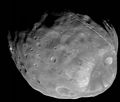Fil:Phobos colour 2008.jpg

Storlek på förhandsvisningen: 636 × 600 pixlar. Andra upplösningar: 255 × 240 pixlar | 509 × 480 pixlar | 815 × 768 pixlar | 1 086 × 1 024 pixlar | 2 172 × 2 048 pixlar | 3 500 × 3 300 pixlar.
Bild i högre upplösning ((3 500 × 3 300 pixlar, filstorlek: 2,72 Mbyte, MIME-typ: image/jpeg))
| Denna fil tillhandahålls av Wikimedia Commons. Informationen från filens beskrivningssida följer nedan. |
Filhistorik
Klicka på ett datum/klockslag för att se filen som den såg ut då.
| Datum/Tid | Miniatyrbild | Dimensioner | Användare | Kommentar | |
|---|---|---|---|---|---|
| nuvarande | 2 april 2018 kl. 05.10 |  | 3 500 × 3 300 (2,72 Mbyte) | Kaldari | more margin on right side |
| 13 november 2008 kl. 06.47 |  | 3 374 × 3 300 (2,7 Mbyte) | Fir0002 | == Summary == {{Information |Description=Colour image of Phobos, imaged by the Mars Reconnaisance Orbiter in 2008 |Source=NASA |Date=9 April 2008 |Location=http://www.nasa.gov/mission_pages/MRO/multimedia/pia10368.html |Author=NASA/J |
Filanvändning
Följande sidor länkar till den här bilden:
Global filanvändning
Följande andra wikier använder denna fil:
- Användande på af.wikipedia.org
- Användande på an.wikipedia.org
- Användande på ar.wikipedia.org
- المريخ
- فوبوس
- قمرا المريخ
- ويكيبيديا:صور مختارة/الفضاء والكون/نظرة إلى الأعلى
- قائمة أجرام المجموعة الشمسية مرتبة حسب الحجم
- بوابة:علم الفلك/صورة مختارة
- بوابة:المريخ/مقالة مختارة/أرشيف
- بوابة:المريخ/مقالة مختارة/2
- قائمة الأقمار الطبيعية
- خط زمني لاكتشاف كواكب المجموعة الشمسية وأقمارها
- ويكيبيديا:ترشيحات الصور المختارة/القمر فوبوس
- ويكيبيديا:صورة اليوم المختارة/أغسطس 2019
- قالب:صورة اليوم المختارة/2019-08-03
- بوابة:علم الفلك/صورة مختارة/73
- معسكر قاعدة المريخ
- ويكيبيديا:صورة اليوم المختارة/يناير 2022
- قالب:صورة اليوم المختارة/2022-01-04
- Användande på ary.wikipedia.org
- Användande på arz.wikipedia.org
- Användande på as.wikipedia.org
- Användande på azb.wikipedia.org
- Användande på az.wikipedia.org
- Användande på be-tarask.wikipedia.org
- Användande på be.wikipedia.org
- Användande på bg.wikipedia.org
- Användande på bh.wikipedia.org
- Användande på bn.wikipedia.org
- Användande på bn.wikibooks.org
- Användande på bs.wikipedia.org
Visa mer globalt användande av denna fil.




